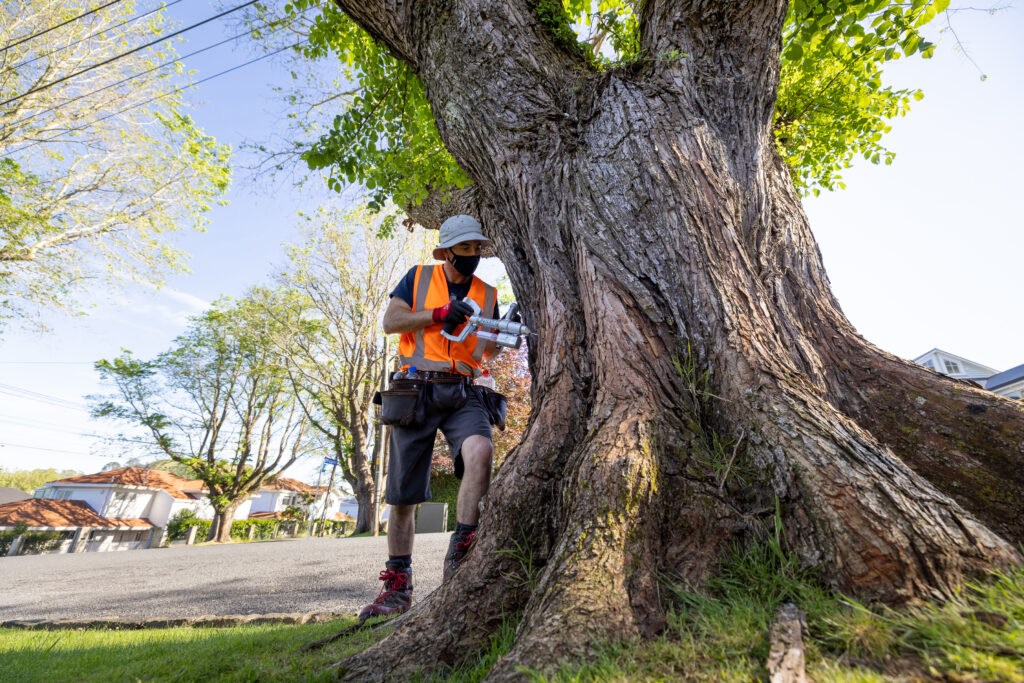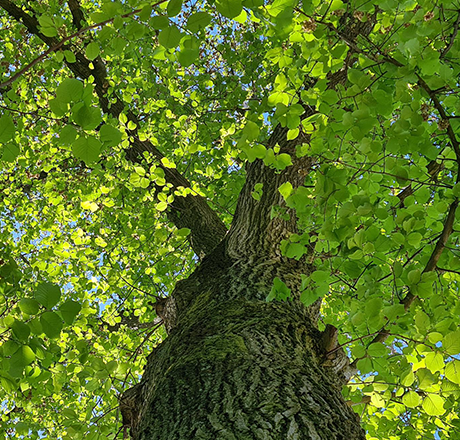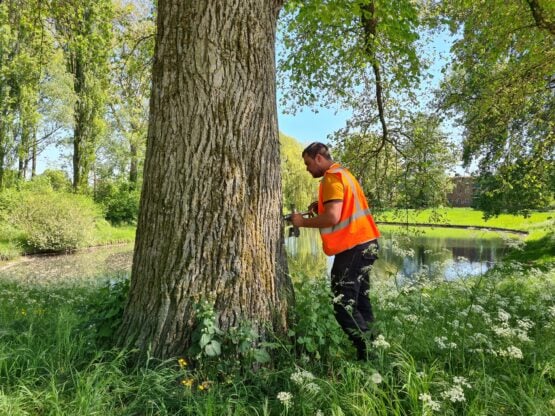
Photo: Cactusphotography©
Simon Cook, 2022: Dutch Elm Disease (DED) was first found in New Zealand in the summer of 1989/99. A large green elm, growing quite happily in a small inner city Auckland park, browned and wilted suddenly. DED had reached our shores, possibly in dunnage or packaging material. The removal of this specimen and all the elms in the park quickly followed. All material was chipped, root plates dug out as best they could and the large pile of debris fumigated with Methyl Bromide then taken to a landfill. Delimiting operations discovered further diseased trees in nearby suburbs. With the elm bark beetle, Scolytus multistriatus, already present in relatively high numbers in northern parts of the North Island, an eradication campaign against Ophiostoma novo-ulmi was initiated by Central Government (Ministry of Forestry, NZ).
Somehow, in 1993 the disease travelled 400km southeast to Napier (Sturms Gully) in the North Island. A large area (200m2) of suckering elms were removed and DED was sucessfully eradicated from the city. This success was largely due to the very slow spread of the only DED beetle vector in NZ, which had yet to reach the region. Scolytus multistriatus is now found throughout the North Island of NZ. By 1993 DED was declared an “Unwanted Organism” under the newly enacted Biosecurity Act 1993, and remains listed there to this day.
Over the past 30 plus years, the number of diseased trees has ebbed and flowed, as has the management of the campaign and the form it has taken. In the early 2000’s single figure numbers of diseased elm were identified, but rather than tightening the noose on the disease’s presence a decision was made to reduce funding (halting beetle trapping & diagnosis of the associated fungal presence on the vector). Then, in 2006 central Government (MAF Biosecurity NZ) made a further decision to ‘transition’ the management of DED control/eradication to the Council in Auckland (at the time Auckland City Council). Following the amalgamation of all Auckland’s councils into one body in 2012, Auckland Council arborists have continued to manage the disease within the Auckland region. I manage the programme as part of my role within Auckland Council.
Over the last decade there has been a steady rise in case numbers within Auckland. This has been incredibly sad, with the loss of significant specimen trees, large elm woodlots and backyard beauties. However, a positive aspect of the ‘Slow to Spread’ programme had been that no infected elms were identified south of the Auckland border. Unfortunately the recent 2021/2022 season’s results have changed this status of the slow-moving epidemic. These newly discovered DED infected sites were identified using an array of pheromone traps set up along borders with the Waikato region, south of Auckland. Of the 38 traps in the array, 13 trapped positive beetles (diagnostics carried out at Scion’s Pathogen Diagnostics and Collections Lab) and 9 of these beetles were trapped in Waikato. After extensive investigative work by Darryn Horrell and the SPS crew, 3 diseased trees (sites) were located and subsequently removed by their owners. Trapping results indicate that there are likely to be more positive trees in the region, so hopefully with the help of Waikato’s Arboricultural and Biosecurity specialists the epidemic’s spread can be halted.
During the 2019/2020 season over $750,000 was spent on removing DED infected elms in Auckland’s streets and parks, by far the greatest amount spent in one financial year. Over the last few years, some of the established elm avenues in the city have been decimated along with notable specimen elms in parks. Added to this, there has been a serious decline in the statutory compliance of landowners to carry out the immediate removal/destruction of DED infected elms growing on their property. This has been partly due to failures in communication about the DED eradication programme. Efforts around informing and motivating the general public regarding the protection of this important urban tree need to be improved. There are still between 15,000-20,000 elms in Auckland, so with 140 plus infected sites last season, it is not all bad news.
There has however been some significant progress over the last couple of years. Firstly, the disease became part of the Auckland Regional Pest Management Plan, providing a platform for greater compliance of control measures. Auckland Council’s Biosecurity team is now available to help with the Programme’s objectives, if required. We also received signoff for a major increase in funding. Auckland Council Arboriculture and Ecological Manager, David Stejskal, convinced upper management that continuing to spend nearly $1million on removals was untenable. With the ongoing loss to Auckland’s treed landscape, if even half the 2019/2020 removals budget was spent instead on control measures, a massive reduction in infection rates would result. This has been taken on board and there are now several contracts in place for various aspects including: old infected rootplate sucker removal, tree removal, surveillance, trapping, diagnostics & rapid reactive branch removal. And now there is the possible gamechanger in the form of DutchTrig. With this addition we may be able to keep infection levels down and reverse that rising trend in case numbers.
Early in 2020, before Covid reached New Zealand, we were visited by Ron Schraven and Thilo Beeker who were keen for us to add the DutchTrig vaccine to our arsenal of weapons against DED in Auckland. Both David and I were really interested. A few weeks later Covid 19 started to bite and as with many Countries around the world we locked ourselves into our personal Island. With the Delta variant rampant across the world, we were quite surprised when Thilo and Ron made contact to say that they had been given approval by the NZ Government to import DutchTrig into the country. This was made acceptable by the fact that the Verticillium fungus, used in the vaccine, was already present in NZ. In early November 2021 I drove to Auckland Airport and picked up the large temperature-controlled box containing 35 DutchTrig vials. We were very excited at this stage. Sadly, over the next couple of days we lost 6 or so vials due to a freezing mishap in a Beer Fridge. We will do better this year!
Unable to get back into NZ, Thilo organised for his colleague Paco Divers to carry out the injections. With the help of Proclimb (contracted to do reactive pruning of recently wilted elm branches) and SPS Biosecurity (our surveillance, trapping and data management contractor), Paco was able to inject a total of 237 elms of various sizes and states over the next week or so. Proclimb dealt with Health & Safety for all sites, plus measurements and SPS Biosecurity entered all the possible information we could gather into our DED Field Maps database. This included photos of every tree, diameter and detailed description of the tree. Paco was great to deal with and the newly leaf bud bursting elms sucked up the vaccine with gusto.
Almost a season on, the results appear to be positive, with only 6 out of 237 injected elms having to be removed due to DED. We did inject trees that may have been infected by root grafting or vector infection in previous seasons, so it was very difficult to know for certain the efficacy of the vaccine in these cases. Some specimens injected, which we were sure would succumb to DED, have survived and flourished. This was despite two hard drought years in 2020-2022 (we had no rain between December 2021 & the end of April this year).
The 2023 season of the DED control and eradication campaign is about to start. We have very good contractors (SPS Biosecurity, Scion, Proclimb, Treescape, Asplundh, Wildlands & Tumahu) working with us, so hopefully the ‘gamechanger’ in DutchTrig can provide that much needed boost to the campaign’s objectives.


